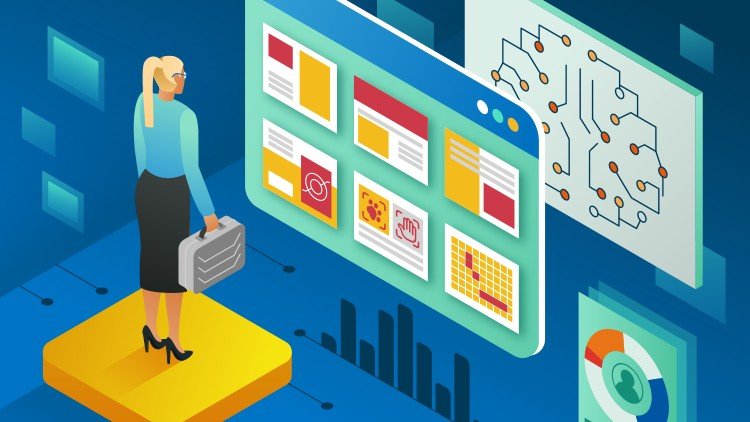Modern Artificial Intelligence Masterclass: Build 6 Projects
- Description
- Curriculum
- FAQ
- Reviews

# Course Update June 2021: Added a study on Explainable AI with Zero Coding
Artificial Intelligence (AI) revolution is here!
“Artificial Intelligence market worldwide is projected to grow by US$284.6 Billion driven by a compounded growth of 43. 9%. Deep Learning, one of the segments analyzed and sized in this study, displays the potential to grow at over 42. 5%.” (Source: globenewswire).
AI is the science that empowers computers to mimic human intelligence such as decision making, reasoning, text processing, and visual perception. AI is a broader general field that entails several sub-fields such as machine learning, robotics, and computer vision.
For companies to become competitive and skyrocket their growth, they need to leverage AI power to improve processes, reduce cost and increase revenue. AI is broadly implemented in many sectors nowadays and has been transforming every industry from banking to healthcare, transportation and technology.
The demand for AI talent has exponentially increased in recent years and it’s no longer limited to Silicon Valley! According to Forbes, AI Skills are among the most in-demand for 2020.
The purpose of this course is to provide you with knowledge of key aspects of modern Artificial Intelligence applications in a practical, easy and fun way. The course provides students with practical hands-on experience using real-world datasets. The course covers many new topics and applications such as Emotion AI, Explainable AI, Creative AI, and applications of AI in Healthcare, Business, and Finance.
One key unique feature of this course is that we will be training and deploying models using Tensorflow 2.0 and AWS SageMaker. In addition, we will cover various elements of the AI/ML workflow covering model building, training, hyper-parameters tuning, and deployment. Furthermore, the course has been carefully designed to cover key aspects of AI such as Machine learning, deep learning, and computer vision.
Here’s a summary of the projects that we will be covering:
· Project #1 (Emotion AI): Emotion Classification and Key Facial Points Detection Using AI
· Project #2 (AI in HealthCare): Brain Tumor Detection and Localization Using AI
· Project #3 (AI in Business/Marketing): Mall Customer Segmentation Using Autoencoders and Unsupervised Machine Learning Algorithms
· Project #4: (AI in Business/Finance): Credit Card Default Prediction Using AWS SageMaker’s XG-Boost Algorithm (AutoPilot)
· Project #5 (Creative AI): Artwork Generation by AI
· Project #6 (Explainable AI): Uncover the Blackbox nature of AI
Who this course is for:
The course is targeted towards AI practitioners, aspiring data scientists, Tech enthusiasts, and consultants wanting to gain a fundamental understanding of data science and solve real world problems. Here’s a list of who is this course for:
· Seasoned consultants wanting to transform industries by leveraging AI.
· AI Practitioners wanting to advance their careers and build their portfolio.
· Visionary business owners who want to harness the power of AI to maximize revenue, reduce costs and optimize their business.
· Tech enthusiasts who are passionate about AI and want to gain real-world practical experience.
Course Prerequisites:
Basic knowledge of programming is recommended. However, these topics will be extensively covered during early course lectures; therefore, the course has no prerequisites, and is open to anyone with basic programming knowledge. Students who enroll in this course will master data science fundamentals and directly apply these skills to solve real world challenging business problems.
-
5Project Introduction and Welcome Message
-
6Task #1 - Understand the Problem Statement & Business Case
-
7Task #2 - Import Libraries and Datasets
-
8Task #3 - Perform Image Visualizations
-
9Task #4 - Perform Images Augmentation
-
10Task #5 - Perform Data Normalization and Scaling
-
11Task #6 - Understand Artificial Neural Networks (ANNs) Theory & Intuition
-
12Task #7 - Understand ANNs Training & Gradient Descent Algorithm
-
13Task #8 - Understand Convolutional Neural Networks and ResNets
-
14Task #9 - Build ResNet to Detect Key Facial Points
-
15Task #10 - Compile and Train Facial Key Points Detector Model
-
16Task #11 - Assess Trained ResNet Model Performance
-
17Task #12 - Import and Explore Facial Expressions (Emotions) Datasets
-
18Task #13 - Visualize Images for Facial Expression Detection
-
19Task #14 - Perform Image Augmentation
-
20Task #15 - Build & Train a Facial Expression Classifier Model
-
21Task #16 - Understand Classifiers Key Performance Indicators (KPIs)
-
22Task #17 - Assess Facial Expression Classifier Model
-
23Task #18 - Make Predictions from Both Models: 1. Key Facial Points & 2. Emotion
-
24Task #19 - Save Trained Model for Deployment
-
25Task #20 - Serve Trained Model in TensorFlow 2.0 Serving
-
26Task #21 - Deploy Both Models and Make Inference
-
27Project Introduction and Welcome Message
-
28Task #1 - Understand the Problem Statement and Business Case
-
29Task #2 - Import Libraries and Datasets
-
30Task #3 - Visualize and Explore Datasets
-
31Task #4 - Understand the Intuition behind ResNet and CNNs
-
32Task #5 - Understand Theory and Intuition Behind Transfer Learning
-
33Task #6 - Train a Classifier Model To Detect Brain Tumors
-
34Task #7 - Assess Trained Classifier Model Performance
-
35Task #8 - Understand ResUnet Segmentation Models Intuition
-
36Task #9 - Build a Segmentation Model to Localize Brain Tumors
-
37Task #10 - Train ResUnet Segmentation Model
-
38Task #11 - Assess Trained ResUNet Segmentation Model Performance
-
39Project Introduction and Welcome Message
-
40Task #1 - Understand AI Applications in Marketing
-
41Task #2 - Import Libraries and Datasets
-
42Task #3 - Perform Exploratory Data Analysis (Part #1)
-
43Task #4 - Perform Exploratory Data Analysis (Part #2)
-
44Task #5 - Understand Theory and Intuition Behind K-Means Clustering Algorithm
-
45Task #6 - Apply Elbow Method to Find the Optimal Number of Clusters
-
46Task #7 - Apply K-Means Clustering Algorithm
-
47Task #8 - Understand Intuition Behind Principal Component Analysis (PCA)
-
48Task #9 - Understand the Theory and Intuition Behind Auto-encoders
-
49Task #10 - Apply Auto-encoders and Perform Clustering
-
50Project Introduction and Welcome Message
-
51Notes on Amazon Web Services (AWS)
-
52Task #1 - Understand the Problem Statement & Business Case
-
53Task #2 - Import Libraries and Datasets
-
54Task #3 - Visualize and Explore Dataset
-
55Task #4 - Clean Up the Data
-
56Task #5 - Understand the Theory & Intuition Behind XG-Boost Algorithm
-
57Task #6 - Understand XG-Boost Algorithm Key Steps
-
58Task #7 - Train XG-Boost Algorithm Using Scikit-Learn
-
59Task #8 - Perform Grid Search and Hyper-parameters Optimization
-
60Task #9 - Understand XG-Boost in AWS SageMaker
-
61Task #10 - Train XG-Boost in AWS SageMaker
-
62Task #11 - Deploy Model and Make Inference
-
63Task #12 - Train and Deploy Model Using AWS AutoPilot (Minimal Coding Required!)
-
64Project Introduction and Welcome Message
-
65Task #1 - Understand the Problem Statement & Business Case
-
66Task #2 - Import Model with Pre-trained Weights
-
67Task #3 - Import and Merge Images
-
68Task #4 - Run the Pre-trained Model and Explore Activations
-
69Task #5 - Understand the Theory & Intuition Behind Deep Dream Algorithm
-
70Task #6 - Understand The Gradient Operations in TF 2.0
-
71Task #7 - Implement Deep Dream Algorithm Part #1
-
72Task #8 - Implement Deep Dream Algorithm Part #2
-
73Task #9 - Apply DeepDream Algorithm to Generate Images
-
74Task #10 - Generate DeepDream Video
-
80What is AWS and Cloud Computing?
-
81Key Machine Learning Components and AWS Tour
-
82Regions and Availability Zones
-
83Amazon S3
-
84EC2 and Identity and Access Management (IAM)
-
85AWS Free Tier Account Setup and Overview
-
86AWS SageMaker Overview
-
87AWS SageMaker Walk-through
-
88AWS SageMaker Studio Overview
-
89AWS SageMaker Studio Walk-through
-
90AWS SageMaker Model Deployment








